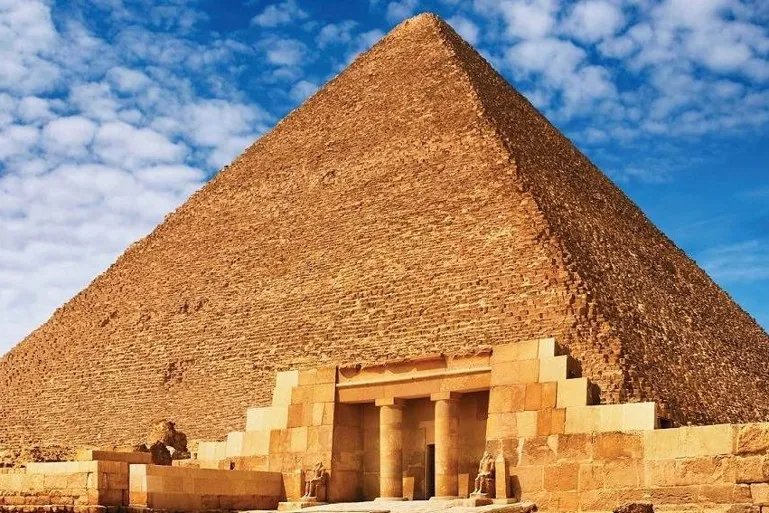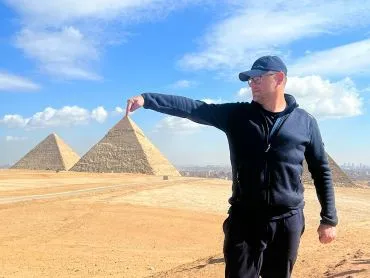Recent News

12
Jan
Great Pyramid Of Giza
Great Pyramid of Giza:
The Great Pyramid of Giza is the largest Egyptian pyramid and served as the tomb of the pharaoh Khufu, who ruled during the Fourth Dynasty of the Old Kingdom. Built in the early 26th century BC over a period of about 27 years, the pyramid is the oldest of the Seven Wonders of the Ancient World and the only wonder to remain largely intact. It is the most famous monument of the Giza pyramid complex, part of the UNESCO World Heritage Site of Memphis and its Necropolis. It lies at the northern end of the line of the three pyramids of Giza.
Originally 146.6 meters (481 feet) tall, the Great Pyramid was the tallest man-made structure in the world for more than 3,800 years. Over time, most of the smooth white limestone shell was removed, reducing the pyramid's height to its current 138.5 meters (454.4 feet). What can be seen today is the underlying core structure. The base area has been measured at about 230.3 square meters (755.6 feet), which corresponds to a volume of about 2.6 million cubic meters (92 million cubic feet), including an inner mound.
The Great Pyramid was built by quarrying an estimated 2.3 million large blocks, weighing a total of 6 million tons. Most of the stones are not uniform in size or shape and are only roughly worked. The outer layers were bonded together with mortar. The construction used mainly local limestone from the Giza Plateau. Additional blocks were imported by boat on the Nile: white limestone from Tura for the casing and granite blocks weighing up to 80 tons from Aswan for the "King's Chamber" structure.
There are three known chambers inside the Great Pyramid. The lowest part was carved into the rock on which the pyramid was built, but remained unfinished. The so-called[8] Queen's Chamber and the King's Chamber, which contain a granite sarcophagus, lie above ground within the pyramid structure. Hemiunu, Khufu's vizier, is considered by some to be the architect of the Great Pyramid. Many different scientific and alternative hypotheses attempt to explain the exact construction techniques.
The funerary complex surrounding the pyramid consisted of two mortuary temples connected by a causeway (one near the pyramid and one near the Nile); tombs for Khufu's immediate family and court, including three smaller pyramids for Khufu's wives; an even smaller "satellite pyramid"; and five buried solar barges.
Ceramic vessels of the Maadi culture dating to the fourth millennium BC have been found near the pyramid, and are believed to be remnants of earlier settlements in the area.
Attribution to Khufu:
uploaded pictureHistorically, the Great Pyramid was attributed to Khufu based on the words of authors of classical antiquity, most notably Herodotus and Diodorus Siculus. However, during the Middle Ages, the construction of the pyramid was also attributed to other people, such as Joseph from the Book of Genesis, Nimrod, or the legendary king Saurid ibn Salhouk.
In 1837, four more relief chambers were found above the King's Chamber after a tunnel was bored to them. The previously inaccessible chambers were covered with hieroglyphs made of red paint. The workers building the pyramid had marked the blocks with the names of their gangs, which included the name of the pharaoh (e.g.: "The gang, the white crown of Khnum-Khufu is powerful"). The names of Khufu were written on the walls over a dozen times. Another of these graffiti was found by Goyon on an outer block of the 4th layer of the pyramid. The inscriptions are comparable to those found at other sites in Khufu, such as the alabaster quarry at Hatnub or the port of Wadi al-Jarf, and are also found in pyramids of other pharaohs.
During the course of the 20th century, the cemeteries adjacent to the pyramid were excavated. Family members and high officials of Khufu were buried in the east field south of the causeway and in the west field. Most notably the wives, children and grandchildren of Khufu, Hemiunu, Ankhaf and (the burial place of) Hetepheres I, the mother of Khufu. As Hassan puts it: “Since the early dynasty, it was always the custom for relatives, friends and courtiers to be buried near the king they had served during his lifetime. This was entirely in keeping with the Egyptian idea of the king's afterlife."
Until the 6th Dynasty, the cemeteries were actively developed and then used less frequently. The earliest pharaonic name on seal impressions is that of Khufu, the latest of Pepi II. Workers' graffiti was also written on some of the stones of the tombs; for example, "Mddw" (Horus name of Khufu) on the mastaba of Chufunacht, probably a grandson of Khufu.
Some inscriptions in the chapels of the mastabas (as in the pyramid, their burial chambers were usually without inscriptions) mention Khufu or his pyramid. For example, an inscription of Mersyankh III states: "Her mother is the daughter of the king of Upper and Lower Egypt Khufu." Most often, these references are part of a title, for example, Snnw-ka, "chief of the settlement and overseer of the pyramid city of Akhet-Khufu" or Merib, "priest of Khufu." Several tomb owners have the Names of a king as part of their own name (e.g. Chufudjedef, Chufuseneb, Merichufu). The earliest pharaoh mentioned in this way at Giza is Snefru (Khufu's father).
In 1936, Hassan discovered a stele of Amenhotep II near the Great Sphinx of Giza, suggesting that the two larger pyramids were still attributed to Cheops and Chephren in the New Kingdom. It states: "When he was still young, he harnessed the horses at Memphis and stopped at the sanctuary of Hor-em-akhet (the Sphinx). There he spent some time walking around, contemplating the beauty of the sanctuary of Khufu and Khafra the Revered."
In 1954, two boat pits were discovered at the south base of the pyramid, one of which contained the Khufu ship. The cartouche of Djedefre was found on many of the blocks covering the boat pits. As the successor and eldest son, he would presumably have been responsible for the burial of Khuop. The second boat pit was examined in 1987; excavation work began in 2010. Graffiti on the stones included four occurrences of the name "Khufu," 11 occurrences of "Djedefre," a year (in reign, season, month, and day), measurements of the stone, various signs and markings, and a reference line used in construction, all in red or black ink.
During excavations in 2013, the diary of Merer was found in Wadi al-Jarf. It documents the transport of white limestone blocks from Tura to the Great Pyramid, which is mentioned dozens of times under its original name Akhet Khufu (with a pyramid determinative). It states that the stones were accepted into She Akhet-Khufu ("the pool of the pyramid horizon of Khufu") and Ro-She Khufu ("the entrance to the pool of Khufu"), which were under the supervision of Ankhhaf, his half-brother and vizier of Cheops, as well as owner of the largest mastaba of the Giza East Field.



_lg.webp)
_lg.webp)

